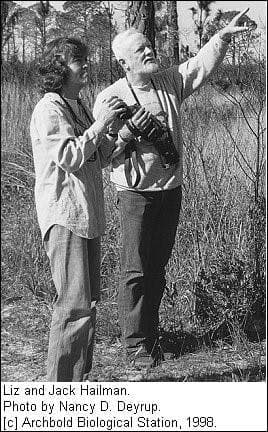
Jack P. Hailman
Jack P. Hailman (1936-2016), Research Associate and long-time collaborator with the Avian Ecology Program at Archbold Biological Station, passed away at his home in Jupiter Inlet Colony, Florida, on January 20, 2016. Jack had a long, productive, and prestigious career in the Department of Zoology at the University of Wisconsin, Madison (1970–1998). During the1970s and 1980s Jack brought his field ethology classes to Florida using Archbold as the basecamp.


Jack Hailman (1936-2016), Research Associate and long-time collaborator with the Avian Ecology Program at Archbold Biological Station, passed away at his home in Jupiter Inlet Colony, FL, on January 20, 2016. Jack had a long, productive, and prestigious career in the Department of Zoology at the University of Wisconsin, Madison (1970 – 1998). He was a Fellow and President of the Animal Behavior Society, as well as Editor of Animal Behaviour. He also was a Fellow of the American Ornithologists’ Union, the American Association for the Advancement of Science, The American Society of Naturalists, and the Royal Norwegian Scientific Academy. Jack was an ethologist, deeply interested in animal behavior, its context and evolution. He was a curious naturalist, often elevating his meticulous field observations into published discussions regarding the function and context of behavior. Jack was prolific, publishing nearly 200 papers and 12 books over his career. He published papers on bird behavior and communication (in a variety of species), loggerhead turtle ethograms, the effects of nocturnal illumination on animal behavior including anurans, shrimp and other species, and cryptic coloration in fish, among other topics, all united by his interest in the evolution of behavior. Like many ethologists he thought comparatively and could often find fascinating patterns in seemingly disparate arenas. His most recent book, published in 2008 entitled “Coding and Redundancy: Man-Made and Animal-Evolved Signals” explored the strikingly similar ways in which information is encoded in nonverbal man-made signals (e.g., traffic lights and tornado sirens) and animal-evolved signals (e.g., color patterns and vocalizations). At Archbold’s traditional afternoon coffee breaks, where science is often discussed and frequently debated, Jack enlivened every conversation with his unique insights and creative corollaries.
The eminent ecologist John T. Emlen introduced Jack to Archbold Biological Station in 1970 and throughout the 70s and 80s Jack brought classes here. By the mid-1980s, he was collaborating with Glen Woolfenden on the long-term study of Florida Scrub-Jays. He mentored 6 graduate students who did their work at Archbold and published 13 papers specific to his and their work. After Jack retired in 1998 and relocated to Florida, he and his wife, Liz, became regular visitors to the Avian Ecology lab, assisting with the monthly jay census and continuing his field research. At his passing, Jack had on-going projects on scrub-jay locomotion, the context of the female-specific hiccup call, and what defines the “adolescence” of a scrub-jay. Jack was constantly active, hiking, traveling, and writing. He embraced digital photography and he and Liz attended almost all meetings of the Archbold photo club. One of his recent books, coauthored with Liz, was “Hiking Circuits in Rocky Mountain National Park,” reflecting his eclectic interests and passion for sharing his knowledge. We will greatly miss Jack, his creativity and fellowship.
See also: Bowman, R., and F.E. Lohrer. 2016. In memoriam: Jack P. Hailman. Auk 133:822-823.